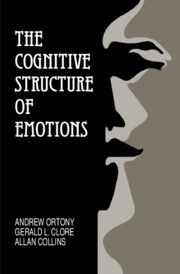Book contents
- Frontmatter
- Contents
- Preface
- 1 Introduction
- 2 The Structure of the Theory
- 3 The Cognitive Psychology of Appraisal
- 4 Factors Affecting the Intensity of Emotions
- 5 Reactions to Events: I
- 6 Reactions to Events: II
- 7 Reactions to Agents
- 8 Reactions to Objects
- 9 The Boundaries of the Theory
- References
- Author Index
- Subject Index
2 - The Structure of the Theory
Published online by Cambridge University Press: 01 June 2011
- Frontmatter
- Contents
- Preface
- 1 Introduction
- 2 The Structure of the Theory
- 3 The Cognitive Psychology of Appraisal
- 4 Factors Affecting the Intensity of Emotions
- 5 Reactions to Events: I
- 6 Reactions to Events: II
- 7 Reactions to Agents
- 8 Reactions to Objects
- 9 The Boundaries of the Theory
- References
- Author Index
- Subject Index
Summary
In discussing the merits and dangers of using linguistic evidence, the last chapter introduced the notion of an emotion type. An emotion type is a distinct kind of emotion that can be realized in a variety of recognizably related forms. The example we gave was of the emotion type, fear, which can be manifested in varying degrees of intensity (marked in English by words such as “concern,” “fright,” “petrified,” and so on), and for which there can be various subtle shifts in emphasis (for example, an emphasis on a particular kind of associated behavior is captured by the word “cowering,” and an emphasis on the object of fear as being psychological rather than physical is captured by the word “anxiety”). This notion of an emotion type is central to the theory. In order to provide a coherent account of the emotions, it is essential to reduce somehow the infinitude of phenomenally possible emotions to manageable proportions. We do this by focusing on the distinct emotion types rather than on the multitude of discriminable emotional states. The question that we then have to address is: What are the distinct emotion types and how are they related to one another?
It seems to us that the distinct emotion types cannot be arranged informatively into any single space of reasonably low dimensionality. Rather, we suspect that the emotions come in groups for which the intragroup structure is quite simple even though the intergroup structure is not (Fillenbaum & Rapaport, 1971).
Information
- Type
- Chapter
- Information
- The Cognitive Structure of Emotions , pp. 15 - 33Publisher: Cambridge University PressPrint publication year: 1988
Accessibility standard: Unknown
Why this information is here
This section outlines the accessibility features of this content - including support for screen readers, full keyboard navigation and high-contrast display options. This may not be relevant for you.Accessibility Information
- 2
- Cited by
